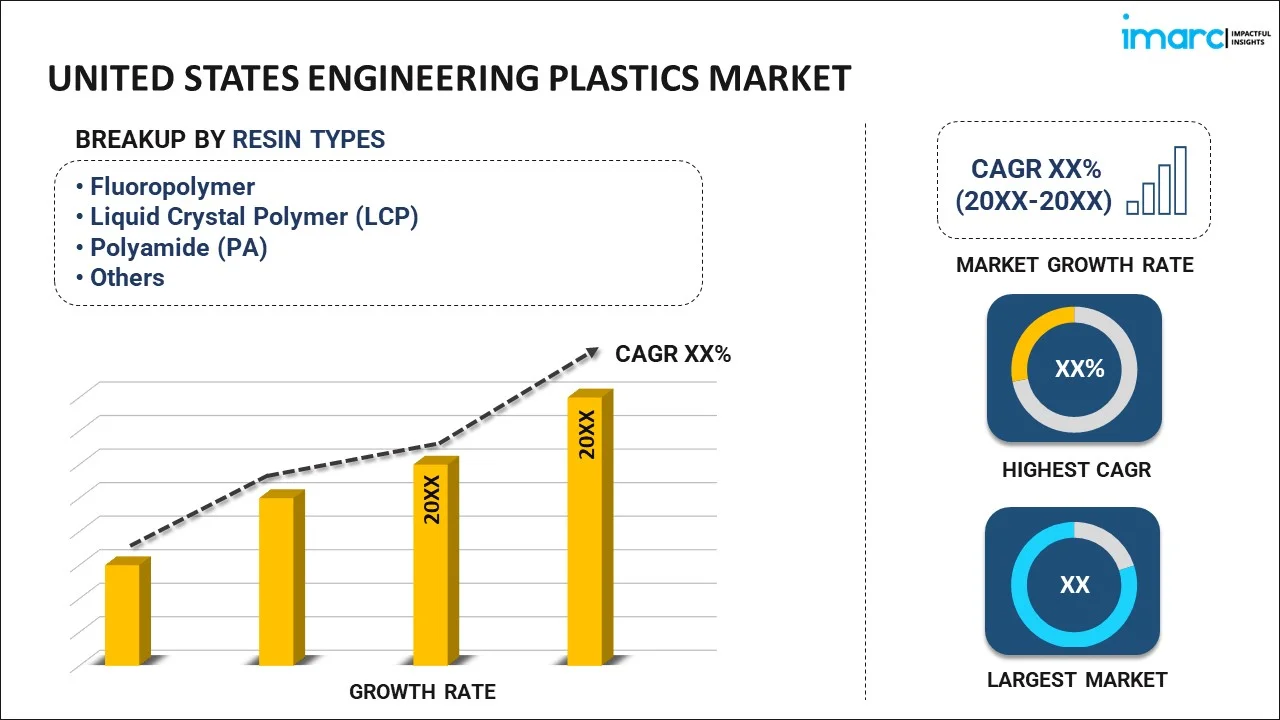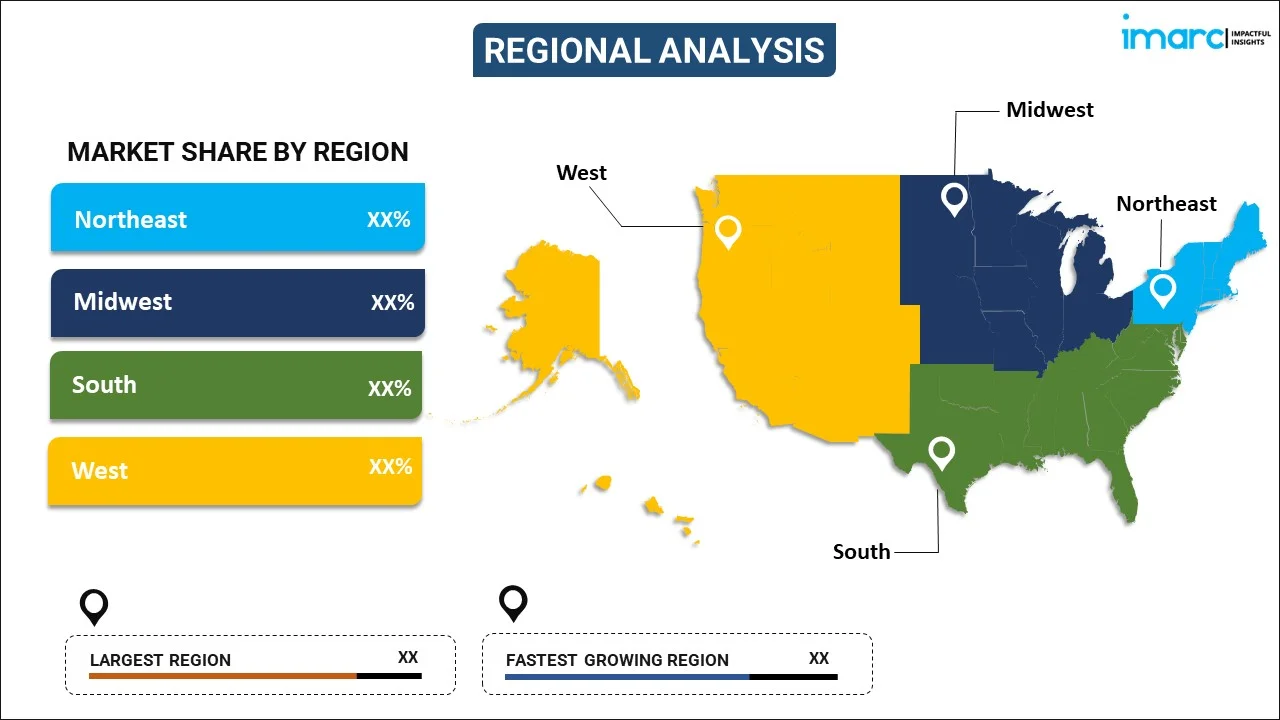
United States Engineering Plastics Market Report by Resin Type (Fluoropolymer, Liquid Crystal Polymer (LCP), Polyamide (PA), Polybutylene Terephthalate (PBT), Polycarbonate (PC), Polyether Ether Ketone (PEEK), Polyethylene Terephthalate (PET), Polyimide (PI), Polymethyl Methacrylate (PMMA), Polyoxymethylene (POM), Styrene Copolymers (ABS and SAN)), End Use Industry (Aerospace, Automotive, Building and Construction, Electrical and Electronics, Industrial and Machinery, Packaging, and Others), and Region 2025-2033
Market Overview:
United States engineering plastics market size is projected to exhibit a growth rate (CAGR) of 6.35% during 2025-2033. The inflating popularity of lightweight automobiles and extensive investments in R&D activities are primarily driving the market growth across the country.
|
Report Attribute
|
Key Statistics
|
|---|---|
|
Base Year
|
2024 |
|
Forecast Years
|
2025-2033 |
|
Historical Years
|
2019-2024
|
| Market Growth Rate (2025-2033) | 6.35% |
Engineering plastics find widespread application in the production of mechanical components, containers, and packaging materials. They serve as a favored alternative to metals and ceramics primarily due to their lightweight nature. Additionally, these plastics exhibit superior load capacity, mechanical strength, thermal stability, and durability, all while offering flexibility in design. Commonly employed variants of engineering plastics include polyamides (PA), polycarbonates (PC), nylon 6, acrylonitrile butadiene styrene (ABS), and polysulphone (PSU). Their utilization spans various industries, contributing to the manufacturing of car bumpers, dashboard trims, ski boots, helmets, and optical discs. The preference for engineering plastics in these applications is driven by their advantageous properties and the versatility they bring to the design and functionality of the final products.
United States Engineering Plastics Market Trends:
The United States engineering plastics market stands as a pivotal sector within the industrial landscape, driven by a myriad of applications and the distinctive properties these materials offer. Their prevalence arises from their ability to serve as lightweight alternatives to traditional metals and ceramics, providing exceptional load capacity, mechanical strength, thermal stability, and durability. Additionally, this versatility is particularly evident in their use across various industries, contributing significantly to the manufacturing of automotive components like bumpers and dashboard trims, as well as consumer goods such as ski boots, helmets, and optical discs. Besides this, as the demand for advanced materials with enhanced performance characteristics continues to rise, the U.S. engineering plastics market remains at the forefront of innovation. Moreover, the adaptability and resilience of these plastics make them indispensable in meeting the evolving needs of industries seeking high-performance solutions for diverse applications. With ongoing technological advancements and a focus on sustainable practices, the engineering plastics market in the United States is poised for continued growth and a central role in shaping the future of manufacturing and product development.
United States Engineering Plastics Market Segmentation:
IMARC Group provides an analysis of the key trends in each segment of the market, along with forecasts at the country levels for 2025-2033. Our report has categorized the market based on resin type and end use industry
Resin Type Insights:

- Fluoropolymer
- Ethylenetetrafluoroethylene (ETFE)
- Fluorinated Ethylene-Propylene (FEP)
- Polytetrafluoroethylene (PTFE)
- Polyvinylfluoride (PVF)
- Polyvinylidene Fluoride (PVDF)
- Others
- Liquid Crystal Polymer (LCP)
- Polyamide (PA)
- Aramid
- Polyamide (PA) 6
- Polyamide (PA) 66
- Polyphthalamide
- Polybutylene Terephthalate (PBT)
- Polycarbonate (PC)
- Polyether Ether Ketone (PEEK)
- Polyethylene Terephthalate (PET)
- Polyimide (PI)
- Polymethyl Methacrylate (PMMA)
- Polyoxymethylene (POM)
- Styrene Copolymers (ABS and SAN)
The report has provided a detailed breakup and analysis of the market based on the resin type. This includes fluoropolymer (ethylenetetrafluoroethylene (ETFE), fluorinated ethylene-propylene (FEP), polytetrafluoroethylene (PTFE), polyvinylfluoride (PVF), polyvinylidene fluoride (PVDF), and others), liquid crystal polymer (LCP), polyamide (PA) (aramid, polyamide (PA) 6, polyamide (PA) 66, and polyphthalamide), polybutylene terephthalate (PBT), polycarbonate (PC), polyether ether ketone (PEEK), polyethylene terephthalate (PET), polyimide (PI), polymethyl methacrylate (PMMA), polyoxymethylene (POM), and styrene copolymers (ABS and SAN).
End Use Industry Insights:
- Aerospace
- Automotive
- Building and Construction
- Electrical and Electronics
- Industrial and Machinery
- Packaging
- Others
A detailed breakup and analysis of the market based on the end use industry have also been provided in the report. This includes aerospace, automotive, building and construction, electrical and electronics, industrial and machinery, packaging, and others.
Regional Insights:

- Northeast
- Midwest
- South
- West
The report has also provided a comprehensive analysis of all the major regional markets, which include Northeast, Midwest, South, and West.
Competitive Landscape:
The market research report has also provided a comprehensive analysis of the competitive landscape. Competitive analysis such as market structure, key player positioning, top winning strategies, competitive dashboard, and company evaluation quadrant has been covered in the report. Also, detailed profiles of all major companies have been provided.
United States Engineering Plastics Market Report Coverage:
| Report Features | Details |
|---|---|
| Base Year of the Analysis | 2024 |
| Historical Period | 2019-2024 |
| Forecast Period | 2025-2033 |
| Units | Million USD |
| Scope of the Report | Exploration of Historical Trends and Market Outlook, Industry Catalysts and Challenges, Segment-Wise Historical and Future Market Assessment:
|
| Resin Types Covered |
|
| End Use Industries Covered | Aerospace, Automotive, Building and Construction, Electrical and Electronics, Industrial and Machinery, Packaging, Others |
| Regions Covered | Northeast, Midwest, South, West |
| Customization Scope | 10% Free Customization |
| Post-Sale Analyst Support | 10-12 Weeks |
| Delivery Format | PDF and Excel through Email (We can also provide the editable version of the report in PPT/Word format on special request) |
Key Questions Answered in This Report:
- How has the United States engineering plastics market performed so far and how will it perform in the coming years?
- What has been the impact of COVID-19 on the United States engineering plastics market?
- What is the breakup of the United States engineering plastics market on the basis of resin type?
- What is the breakup of the United States engineering plastics market on the basis of end use industry?
- What are the various stages in the value chain of the United States engineering plastics market?
- What are the key driving factors and challenges in the United States engineering plastics?
- What is the structure of the United States engineering plastics market and who are the key players?
- What is the degree of competition in the United States engineering plastics market?
Key Benefits for Stakeholders:
- IMARC’s industry report offers a comprehensive quantitative analysis of various market segments, historical and current market trends, market forecasts, and dynamics of the United States engineering plastics market from 2019-2033.
- The research report provides the latest information on the market drivers, challenges, and opportunities in the United States engineering plastics market.
- Porter's five forces analysis assist stakeholders in assessing the impact of new entrants, competitive rivalry, supplier power, buyer power, and the threat of substitution. It helps stakeholders to analyze the level of competition within the United States engineering plastics industry and its attractiveness.
- Competitive landscape allows stakeholders to understand their competitive environment and provides an insight into the current positions of key players in the market.
Need more help?
- Speak to our experienced analysts for insights on the current market scenarios.
- Include additional segments and countries to customize the report as per your requirement.
- Gain an unparalleled competitive advantage in your domain by understanding how to utilize the report and positively impacting your operations and revenue.
- For further assistance, please connect with our analysts.
 Inquire Before Buying
Inquire Before Buying
 Speak to an Analyst
Speak to an Analyst
 Request Brochure
Request Brochure
 Request Customization
Request Customization




.webp)




.webp)












